An official website of the United States government
 United States Department of Labor
United States Department of Labor
Operate mechanical boom and cable or tower and cable equipment to lift and move materials, machines, or products in many directions.
Employment estimate and mean wage estimates for Crane and Tower Operators:
| Employment (1) | Employment RSE (3) |
Mean hourly wage |
Mean annual wage (2) |
Wage RSE (3) |
|---|---|---|---|---|
| 44,060 | 3.3 % | $ 30.77 | $ 64,010 | 1.9 % |
Percentile wage estimates for Crane and Tower Operators:
| Percentile | 10% | 25% | 50% (Median) |
75% | 90% |
|---|---|---|---|---|---|
| Hourly Wage | $ 16.43 | $ 21.28 | $ 28.71 | $ 36.63 | $ 46.07 |
| Annual Wage (2) | $ 34,170 | $ 44,270 | $ 59,710 | $ 76,190 | $ 95,820 |
Industries with the highest published employment and wages for Crane and Tower Operators are provided. For a list of all industries with employment in Crane and Tower Operators, see the Create Customized Tables function.
Industries with the highest levels of employment in Crane and Tower Operators:
| Industry | Employment (1) | Percent of industry employment | Hourly mean wage | Annual mean wage (2) |
|---|---|---|---|---|
| Other Specialty Trade Contractors | 11,560 | 1.66 | $ 37.36 | $ 77,710 |
| Merchant Wholesalers, Durable Goods (4232, 4233, 4235, 4236, 4237, and 4239 only) | 4,570 | 0.33 | $ 22.71 | $ 47,230 |
| Iron and Steel Mills and Ferroalloy Manufacturing | 2,850 | 3.43 | $ 23.51 | $ 48,900 |
| Support Activities for Water Transportation | 2,440 | 2.77 | $ 31.87 | $ 66,290 |
| Nonresidential Building Construction | 1,850 | 0.23 | $ 35.94 | $ 74,750 |
Industries with the highest concentration of employment in Crane and Tower Operators:
| Industry | Employment (1) | Percent of industry employment | Hourly mean wage | Annual mean wage (2) |
|---|---|---|---|---|
| Iron and Steel Mills and Ferroalloy Manufacturing | 2,850 | 3.43 | $ 23.51 | $ 48,900 |
| Support Activities for Water Transportation | 2,440 | 2.77 | $ 31.87 | $ 66,290 |
| Other Specialty Trade Contractors | 11,560 | 1.66 | $ 37.36 | $ 77,710 |
| Support Activities for Rail Transportation | 350 | 1.03 | $ 35.69 | $ 74,230 |
| Steel Product Manufacturing from Purchased Steel | 550 | 1.00 | $ 22.38 | $ 46,540 |
Top paying industries for Crane and Tower Operators:
| Industry | Employment (1) | Percent of industry employment | Hourly mean wage | Annual mean wage (2) |
|---|---|---|---|---|
| Electric Power Generation, Transmission and Distribution | 80 | 0.02 | $ 40.33 | $ 83,880 |
| Other Specialty Trade Contractors | 11,560 | 1.66 | $ 37.36 | $ 77,710 |
| Residential Building Construction | (8) | (8) | $ 36.89 | $ 76,740 |
| Nonresidential Building Construction | 1,850 | 0.23 | $ 35.94 | $ 74,750 |
| Petroleum and Coal Products Manufacturing | 30 | 0.03 | $ 35.89 | $ 74,650 |
States and areas with the highest published employment, location quotients, and wages for Crane and Tower Operators are provided. For a list of all areas with employment in Crane and Tower Operators, see the Create Customized Tables function.
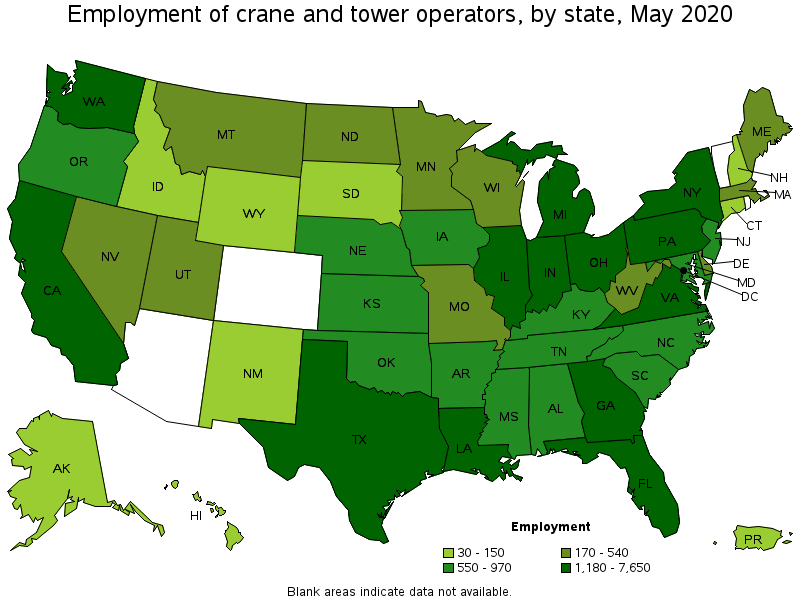
States with the highest employment level in Crane and Tower Operators:
| State | Employment (1) | Employment per thousand jobs | Location quotient (9) | Hourly mean wage | Annual mean wage (2) |
|---|---|---|---|---|---|
| Texas | 7,650 | 0.63 | 2.00 | $ 29.14 | $ 60,610 |
| California | 2,970 | 0.18 | 0.57 | $ 41.28 | $ 85,860 |
| Florida | 2,670 | 0.32 | 1.00 | $ 29.36 | $ 61,060 |
| Pennsylvania | 2,290 | 0.42 | 1.31 | $ 26.26 | $ 54,630 |
| Louisiana | 1,890 | 1.05 | 3.31 | $ 29.98 | $ 62,360 |
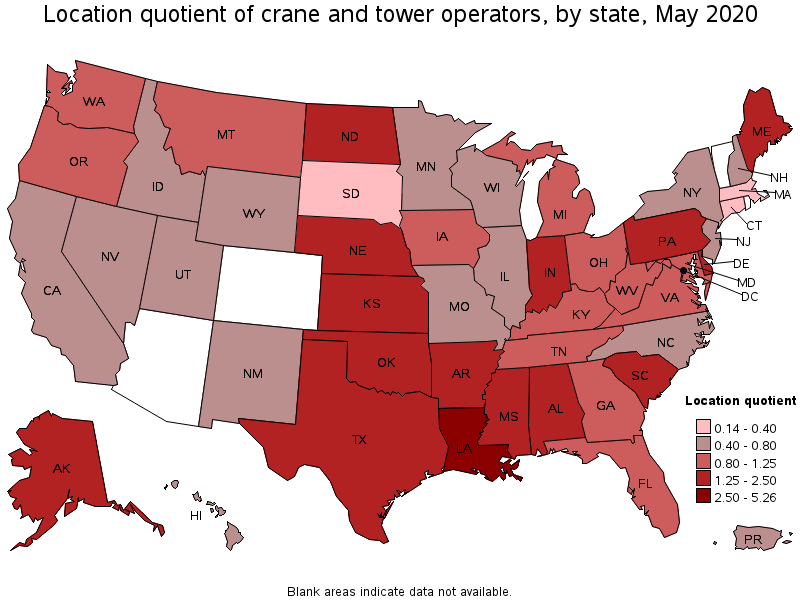
States with the highest concentration of jobs and location quotients in Crane and Tower Operators:
| State | Employment (1) | Employment per thousand jobs | Location quotient (9) | Hourly mean wage | Annual mean wage (2) |
|---|---|---|---|---|---|
| Louisiana | 1,890 | 1.05 | 3.31 | $ 29.98 | $ 62,360 |
| Texas | 7,650 | 0.63 | 2.00 | $ 29.14 | $ 60,610 |
| Mississippi | 680 | 0.63 | 1.99 | $ 23.39 | $ 48,650 |
| Arkansas | 700 | 0.60 | 1.88 | $ 22.34 | $ 46,470 |
| Nebraska | 550 | 0.58 | 1.84 | $ 25.57 | $ 53,190 |
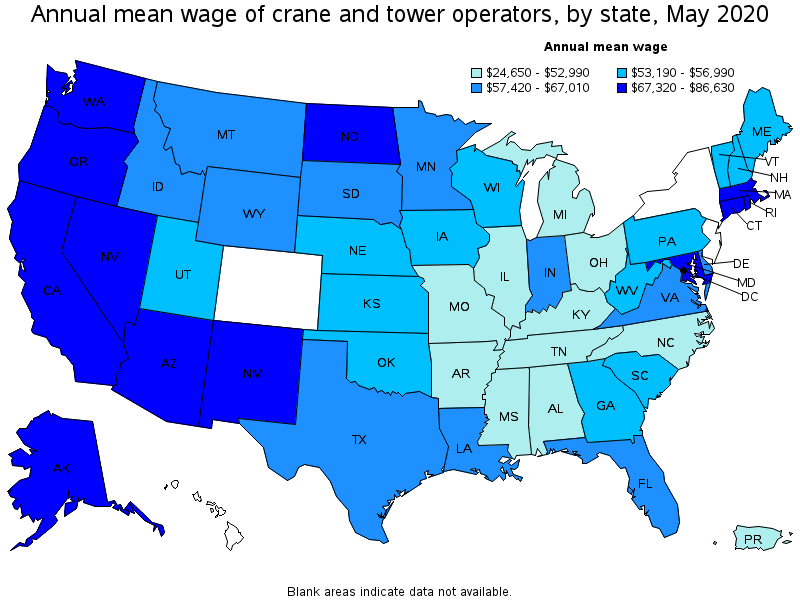
Top paying states for Crane and Tower Operators:
| State | Employment (1) | Employment per thousand jobs | Location quotient (9) | Hourly mean wage | Annual mean wage (2) |
|---|---|---|---|---|---|
| Rhode Island | (8) | (8) | (8) | $ 41.65 | $ 86,630 |
| California | 2,970 | 0.18 | 0.57 | $ 41.28 | $ 85,860 |
| District of Columbia | 30 | 0.04 | 0.14 | $ 38.58 | $ 80,250 |
| Nevada | 220 | 0.18 | 0.55 | $ 36.84 | $ 76,630 |
| Washington | 1,180 | 0.37 | 1.17 | $ 36.82 | $ 76,580 |
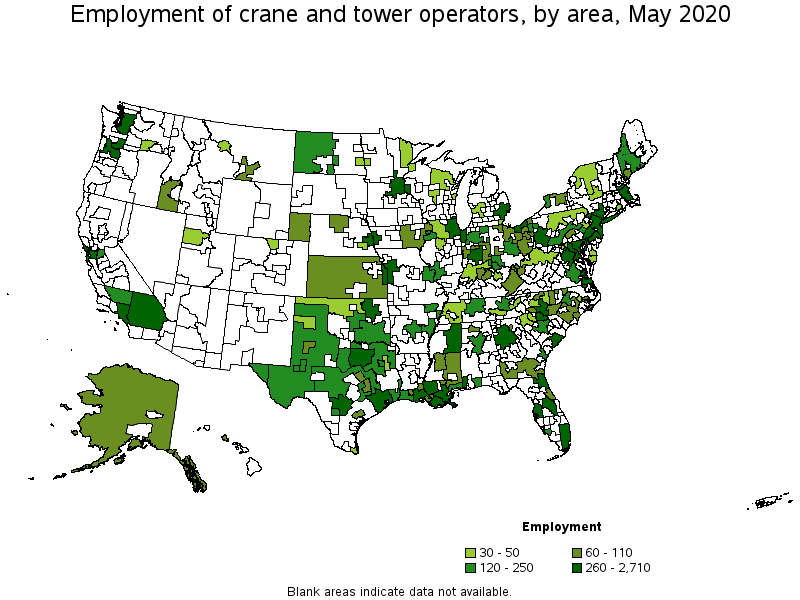
Metropolitan areas with the highest employment level in Crane and Tower Operators:
| Metropolitan area | Employment (1) | Employment per thousand jobs | Location quotient (9) | Hourly mean wage | Annual mean wage (2) |
|---|---|---|---|---|---|
| Houston-The Woodlands-Sugar Land, TX | 2,710 | 0.91 | 2.88 | $ 29.07 | $ 60,460 |
| New York-Newark-Jersey City, NY-NJ-PA | 1,440 | 0.16 | 0.52 | (8) | (8) |
| Dallas-Fort Worth-Arlington, TX | 1,330 | 0.37 | 1.17 | $ 29.69 | $ 61,760 |
| Los Angeles-Long Beach-Anaheim, CA | 1,140 | 0.20 | 0.62 | (8) | (8) |
| Chicago-Naperville-Elgin, IL-IN-WI | 1,100 | 0.25 | 0.80 | $ 24.15 | $ 50,230 |
| Detroit-Warren-Dearborn, MI | 900 | 0.51 | 1.60 | $ 21.08 | $ 43,850 |
| Virginia Beach-Norfolk-Newport News, VA-NC | 880 | 1.22 | 3.84 | $ 30.71 | $ 63,880 |
| Seattle-Tacoma-Bellevue, WA | 770 | 0.39 | 1.24 | $ 39.04 | $ 81,210 |
| Pittsburgh, PA | 760 | 0.71 | 2.24 | $ 19.86 | $ 41,310 |
| Philadelphia-Camden-Wilmington, PA-NJ-DE-MD | 610 | 0.23 | 0.72 | $ 29.72 | $ 61,810 |
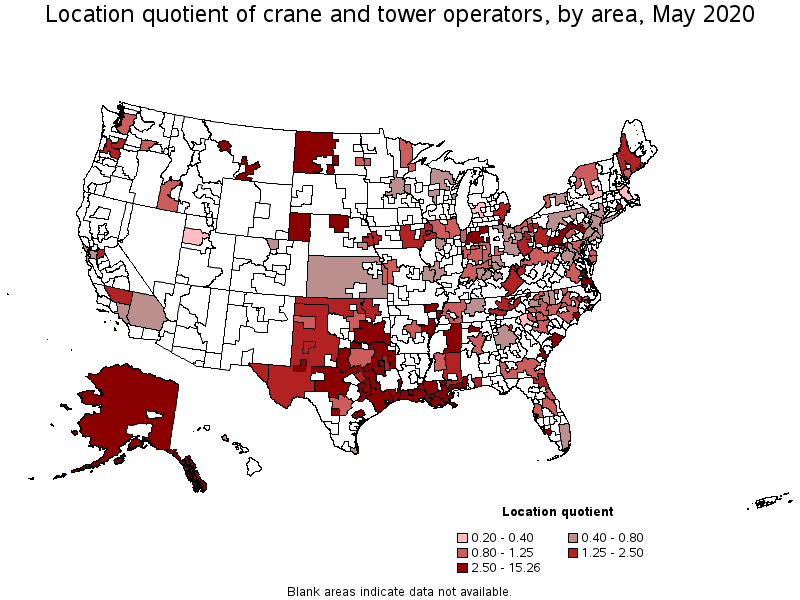
Metropolitan areas with the highest concentration of jobs and location quotients in Crane and Tower Operators:
| Metropolitan area | Employment (1) | Employment per thousand jobs | Location quotient (9) | Hourly mean wage | Annual mean wage (2) |
|---|---|---|---|---|---|
| Houma-Thibodaux, LA | 390 | 4.83 | 15.26 | $ 33.00 | $ 68,650 |
| Victoria, TX | 110 | 3.07 | 9.69 | $ 33.01 | $ 68,660 |
| Odessa, TX | 210 | 2.88 | 9.09 | $ 31.00 | $ 64,480 |
| Mobile, AL | 360 | 2.11 | 6.67 | $ 25.23 | $ 52,490 |
| Lake Charles, LA | 200 | 1.95 | 6.15 | $ 32.16 | $ 66,880 |
| Decatur, AL | 80 | 1.50 | 4.74 | $ 19.51 | $ 40,580 |
| Tyler, TX | 140 | 1.43 | 4.51 | $ 34.27 | $ 71,280 |
| Monroe, MI | 50 | 1.39 | 4.40 | (8) | (8) |
| Lafayette, LA | 260 | 1.35 | 4.26 | $ 26.98 | $ 56,120 |
| Beaumont-Port Arthur, TX | 200 | 1.30 | 4.10 | $ 31.42 | $ 65,360 |
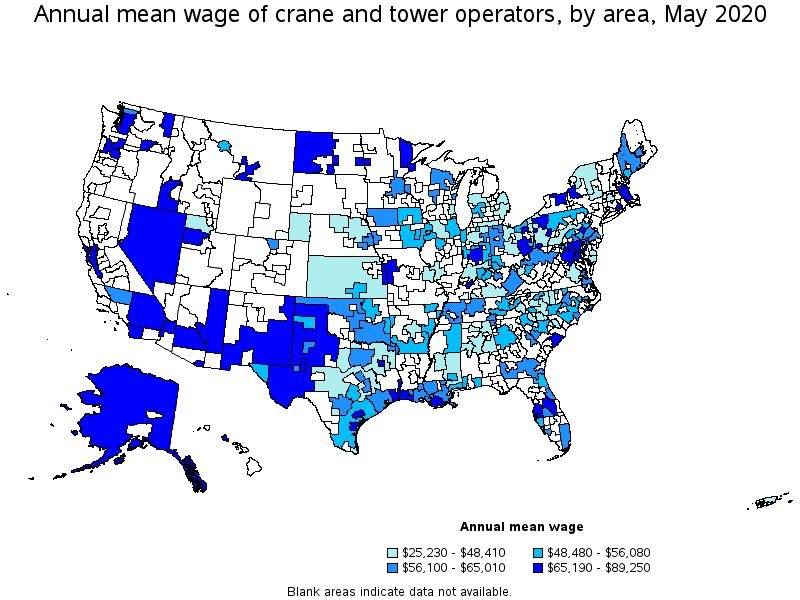
Top paying metropolitan areas for Crane and Tower Operators:
| Metropolitan area | Employment (1) | Employment per thousand jobs | Location quotient (9) | Hourly mean wage | Annual mean wage (2) |
|---|---|---|---|---|---|
| San Diego-Carlsbad, CA | (8) | (8) | (8) | $ 42.91 | $ 89,250 |
| Urban Honolulu, HI | 60 | 0.15 | 0.48 | $ 40.71 | $ 84,670 |
| Vallejo-Fairfield, CA | (8) | (8) | (8) | $ 40.58 | $ 84,410 |
| Reading, PA | 180 | 1.09 | 3.44 | $ 39.85 | $ 82,890 |
| Seattle-Tacoma-Bellevue, WA | 770 | 0.39 | 1.24 | $ 39.04 | $ 81,210 |
| Washington-Arlington-Alexandria, DC-VA-MD-WV | 550 | 0.18 | 0.57 | $ 39.01 | $ 81,140 |
| San Francisco-Oakland-Hayward, CA | 350 | 0.15 | 0.47 | $ 38.83 | $ 80,780 |
| Kennewick-Richland, WA | 40 | 0.39 | 1.23 | $ 37.75 | $ 78,510 |
| Riverside-San Bernardino-Ontario, CA | 340 | 0.23 | 0.72 | $ 36.55 | $ 76,030 |
| Billings, MT | 80 | 1.00 | 3.15 | $ 36.20 | $ 75,310 |
Nonmetropolitan areas with the highest employment in Crane and Tower Operators:
| Nonmetropolitan area | Employment (1) | Employment per thousand jobs | Location quotient (9) | Hourly mean wage | Annual mean wage (2) |
|---|---|---|---|---|---|
| Northeast Mississippi nonmetropolitan area | 290 | 1.27 | 4.02 | $ 23.40 | $ 48,680 |
| East Arkansas nonmetropolitan area | 250 | 3.84 | 12.13 | $ 24.37 | $ 50,680 |
| North Texas Region of Texas nonmetropolitan area | 250 | 0.92 | 2.92 | $ 19.80 | $ 41,180 |
| Northern Indiana nonmetropolitan area | 220 | 1.06 | 3.36 | $ 19.41 | $ 40,380 |
| Hill Country Region of Texas nonmetropolitan area | 160 | 0.82 | 2.58 | $ 20.65 | $ 42,960 |
Nonmetropolitan areas with the highest concentration of jobs and location quotients in Crane and Tower Operators:
| Nonmetropolitan area | Employment (1) | Employment per thousand jobs | Location quotient (9) | Hourly mean wage | Annual mean wage (2) |
|---|---|---|---|---|---|
| East Arkansas nonmetropolitan area | 250 | 3.84 | 12.13 | $ 24.37 | $ 50,680 |
| Northwest Nebraska nonmetropolitan area | 90 | 2.42 | 7.65 | $ 20.19 | $ 41,990 |
| West North Dakota nonmetropolitan area | 160 | 1.35 | 4.26 | $ 34.42 | $ 71,580 |
| Northeast Mississippi nonmetropolitan area | 290 | 1.27 | 4.02 | $ 23.40 | $ 48,680 |
| Alaska nonmetropolitan area | 110 | 1.15 | 3.62 | $ 34.86 | $ 72,520 |
Top paying nonmetropolitan areas for Crane and Tower Operators:
| Nonmetropolitan area | Employment (1) | Employment per thousand jobs | Location quotient (9) | Hourly mean wage | Annual mean wage (2) |
|---|---|---|---|---|---|
| Nevada nonmetropolitan area | (8) | (8) | (8) | $ 39.57 | $ 82,300 |
| Western Pennsylvania nonmetropolitan area | (8) | (8) | (8) | $ 39.33 | $ 81,810 |
| West Texas Region of Texas nonmetropolitan area | 120 | 0.63 | 1.99 | $ 36.25 | $ 75,400 |
| Alaska nonmetropolitan area | 110 | 1.15 | 3.62 | $ 34.86 | $ 72,520 |
| West North Dakota nonmetropolitan area | 160 | 1.35 | 4.26 | $ 34.42 | $ 71,580 |
These estimates are calculated with data collected from employers in all industry sectors, all metropolitan and nonmetropolitan areas, and all states and the District of Columbia. The top employment and wage figures are provided above. The complete list is available in the downloadable XLS files.
The percentile wage estimate is the value of a wage below which a certain percent of workers fall. The median wage is the 50th percentile wage estimate—50 percent of workers earn less than the median and 50 percent of workers earn more than the median. More about percentile wages.
(1) Estimates for detailed occupations do not sum to the totals because the totals include occupations not shown separately. Estimates do not include self-employed workers.
(2) Annual wages have been calculated by multiplying the hourly mean wage by a "year-round, full-time" hours figure of 2,080 hours; for those occupations where there is not an hourly wage published, the annual wage has been directly calculated from the reported survey data.
(3) The relative standard error (RSE) is a measure of the reliability of a survey statistic. The smaller the relative standard error, the more precise the estimate.
(8) Estimate not released.
(9) The location quotient is the ratio of the area concentration of occupational employment to the national average concentration. A location quotient greater than one indicates the occupation has a higher share of employment than average, and a location quotient less than one indicates the occupation is less prevalent in the area than average.
Other OEWS estimates and related information:
May 2020 National Occupational Employment and Wage Estimates
May 2020 State Occupational Employment and Wage Estimates
May 2020 Metropolitan and Nonmetropolitan Area Occupational Employment and Wage Estimates
May 2020 National Industry-Specific Occupational Employment and Wage Estimates
Last Modified Date: March 31, 2021